Research work
Soft Two-Dimensional Polymer Materials and Their Applications
Our group focus on synthesis and structure control of 2D organic and inorganic polymer materials with characteristic structures, such as layered and nanosheet materials. These functional polymer materials are applied to energy- and environment-related applications. Small-data materials informatics combined with data scientific method and chemical perspective is studied to realize efficient exploration of advanced functional materials.
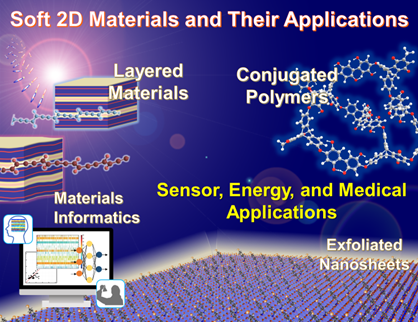
See the more detailed concepts in review papers:
“Morphology Design of Crystalline and Polymer Materials from Nanoscopic to Macroscopic Scales”
Bull. Chem. Soc. Jpn. 2017, 90, 776 (Award Account).
“Crystal-controlled polymerization: Recent advances in morphology design and control of organic polymer materials”
Journal of Materials Chemistry A 2018, 6, 23197.
(1) Morphology control of conjugated polymer materials from nanoscopic to macroscopic scales and their application to energy-related functional materials
Our group has studied morphology control of polymer materials, such as two-dimensional (2D) nanostructures and hierarchical structures from nanoscale to macroscopic scales. A variety of methods to control the nanostructures, such as application of templates and phase separations, were studied in previous works. We have developed new unique approaches for morphology control, such as application of crystal surfaces and morphologies, use of monomer vapor, and composite formation with the other materials, distinguished from typical methods (See the images). The resultant polymers were used for energy-related applications, such as energy storage and electrocatalyst.
The hierarchical structures of crystalline materials were replicated to polymer materials through polymerization in the nanoscale interspace of the original crystals.[1-8] For example, the hierarchical polypyrrole and polystyrene had both the nanoscale structures with high specific surface area and micrometer-scale pathway. These polymers showed the improved performances as to energy-storage and adsorbent.[8-10]
A variety of heteroaromatic monomers were polymerized with organic and inorganic oxidants.[9-14,16-18] For example, when volatile heteroaromatic monomer is set in a closed vessel with certain inorganic oxidative agent, the heteroaromatic polymers, such as polypyrrole and polythiophene derivatives, are coated on substrates and substances in the vessel.[4,14,17] This vapor-phase coating of conductive polymers is achieved at low temperature under ambient pressure. When quinone derivatives are used as the oxidants, conductive polymer with a variety of morphologies are obtained on the surface of the quinone crystals. Moreover, the composites of quinone derivatives and conductive polymers showed the high specific capacity originating from the redox reactions of the both active materials.[10,11,13] In specific cases, the random copolymer of quinone and heteroaromatic polymer forms the graphitic layers.[17] The exfoliated nanosheets showed the enhanced electrocatalytic performances as hydrogen evolution reaction.
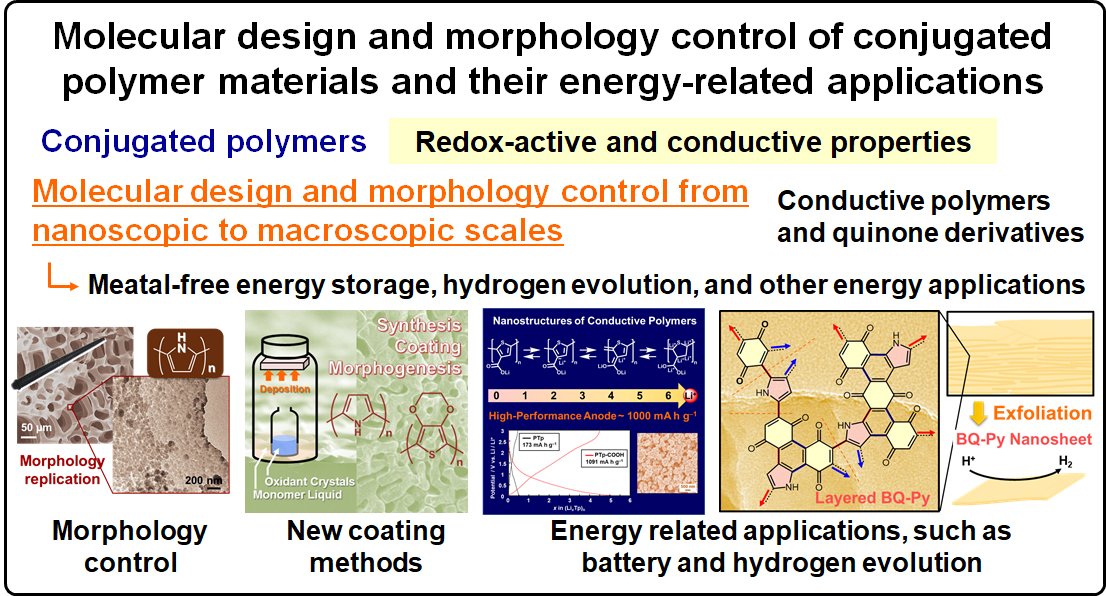
Related publications
- J. Am. Chem. Soc. 2011, 133, 8594.
- J. Mater. Chem. 2012, 22, 21195.
- Chem. Eur. J. 2013, 19, 2284.
- Chem. Commun. 2014, 50, 11840.
- Langmuir 2014, 30, 3236.
- Polym. J. 2015, 47, 183.
- Nanoscale 2015, 7, 3466.
- Chem. Commun. 2015, 51, 7919.
- Chem. Commun. 2015, 51, 9698.
- Chem. Lett. 2016, 45, 324.
- ChemPlusChem 2017, 82, 177.
- NPG Asia Mater. 2017, 9, e377.
- Chem. Commun. 2017, 53, 7329.
- Nanoscale 2017, 9, 7895.
- NPG Asia Mater. 2018, 10, 397.
- ACS Appl. Nano Mater. 2018, 1, 4218.
- Commun. Chem. 2019, 2, 97.
- Adv. Theory Simul. 2019, 2, 1900130.
- Chem.Sci. 2020, 11, 7003.
- ACS Appl. Energy Mater. 2022, 5, 2074.
- ACS Appl. Energy Mater. 2022, 5, 8990.
Accounts
- Bull. Chem. Soc. Jpn. 2017, 90, 776.
- J. Mater. Chem. A 2018, 6, 23197.
(2) Organic layered materials with tunable stimuli-responsive color-change properties
In general, layered materials represent inorganic layered compounds. Our group has focused on organic layered materials, such as layered polydiacetylene (PDA). Organic layered materials have intercalation nature, soft structure, and dynamic function. We studied the morphology and orientation control of such organic crystals on substrates.[1-3] The intercalation affords to control the layered structures and their dynamic functions.[4-11] The stimuli-responsive color-change properties of layered PDA were tuned by the types of the intercalated guests. Our intention is to visualize and quantify a variety of external stimuli, such as heat, light, and force. For example, 2D and 3D temperature distributions were visualized and quantified by the PDA-based paper device.[6,13] Moreover, friction force was visualized and quantified by this device.[10,14] If the stimuli is not directly detected by PDA, the stimuli conversion can induce the color changes.[12,15] NIR and microwave were visualized and quantified by the composite device of PDA and other polymers.[12,15] Our motivation is visualization and quantification of a variety of external stimuli.
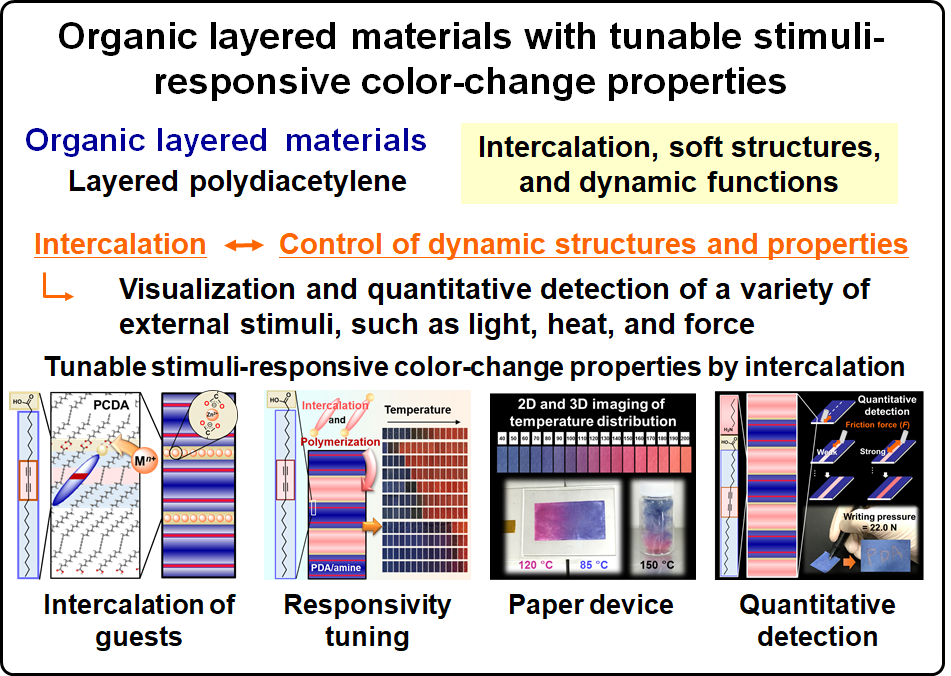
Related publications
- J. Mater. Chem. 2012, 22, 22686.
- Bull. Chem. Soc. Jpn. 2015, 88, 1459.
- Chem. Mater. 2015, 27, 2627.
- Adv. Funct. Mater. 2016, 26, 3463.
- Chem. Sci. 2017, 8, 647.
- ACS Appl. Mater. Interfaces 2017, 9, 16546.
- Chem 2017, 3, 509.
- J. Mater. Chem. C 2017, 5, 8250.
- Polym. J. 2018, 50, 319.
- Adv. Mater. 2018, 30, 1801121.
- Adv. Funct. Mater. 2018, 28, 1804906.
- J. Mater. Chem. C 2019, 7, 4089.
- Chem. Commun. 2019, 55, 11723.
- J. Mater. Chem. C 2020, 8, 1265.
- ACS Sens. 2020, 5, 11723.
- Small 2020,16, 2004586.
- Adv. Mater. 2021,33, 2008755.
- ChemPlusChem 2021, in press.
- Sens. Diagn. 2022,1, 160.
- ACS Appl. Mater. Interfaces 2022, 14, 43792.
Accounts
- Chem. Commun. 2020, 56, 13069.
(3) Structure design and synthesis of inorganic nanosheet materials
Recently, 2D nanomaterials have attracted much interest. Our group focuses on layered transition metal oxides and their exfoliation into the nanosheets. In general, exfoliation of these rigid layered compounds is performed in aqueous and polar organic media. We also study the size control of the nanosheets.[1-3] However, It is not easy to control the size and surface chemistry. We found that new exfoliation methods using soft layered composite materials.[4-12] The layered composites of the host layers and guest molecules are exfoliated into the surface-modified nanosheets in a variety of media. The affinity between the guest and medium plays important roles for the exfoliation process. Recently, we found that materials informatics is a powerful tool for the improvement of the yield and control of the size.[11]
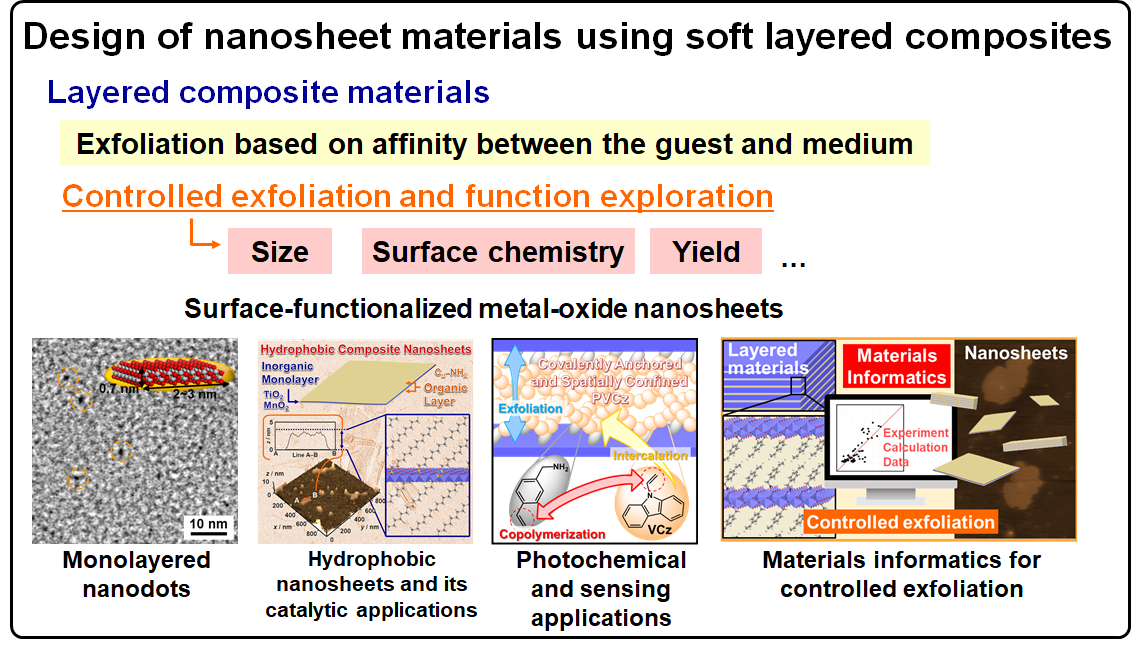
Related publications
- Adv. Funct. Mater. 2010, 20, 4127.
- Chem. Eur. J. 2012, 18, 2825.
- J. Am. Chem. Soc. 2013, 135, 4501.
- Chem. Mater. 2014, 26, 3579.
- Chem. Commun. 2015, 51, 10046.
- Phys. Chem. Chem. Phys. 2015, 17, 32498.
- Nanoscale 2016, 8, 11076.
- Chem. Commun. 2016, 52, 9466.
- Adv. Mater. Interface 2017, 4, 1601014.
- Chem. Commun. 2018, 54, 244.
- Adv. Theory Simul. 2019, 2, 1800180.
- Bull. Chem. Soc. Jpn. 2019, 92, 779.
- Nanoscale Adv. 2020, 2, 1168.
- Adv. Theory Simul. 2020, 3, 2000084.
- Nanoscale 2021, 13, 3853.
- Adv. Theory Simul. 2021, 4, 2100158.
- Digital Discovery 2022, 1, 26.
- Advanced Materials Interfaces 2022, 9, 2201111.
- iScience 2022, 25 , 104933.
Accounts
- Chem. Lett. 2020, 50, 305.
(4) Experiment-oriented materials informatics on small-scale data
In recent years, data-scientific approaches have been applied to chemistry and materials science. Machine learning is typically applied to bigdata. However, sufficient bigdata is not always prepared for machine learning. Our group has focused on small data, such as experimental data in laboratory. Combination of machine learning and our chemical perspective can provide the straightforward predictors with moderate accuracy. This experiment-oriented materials informatics is applied to discovery of materials, optimization of processes, and enhancement of performances.
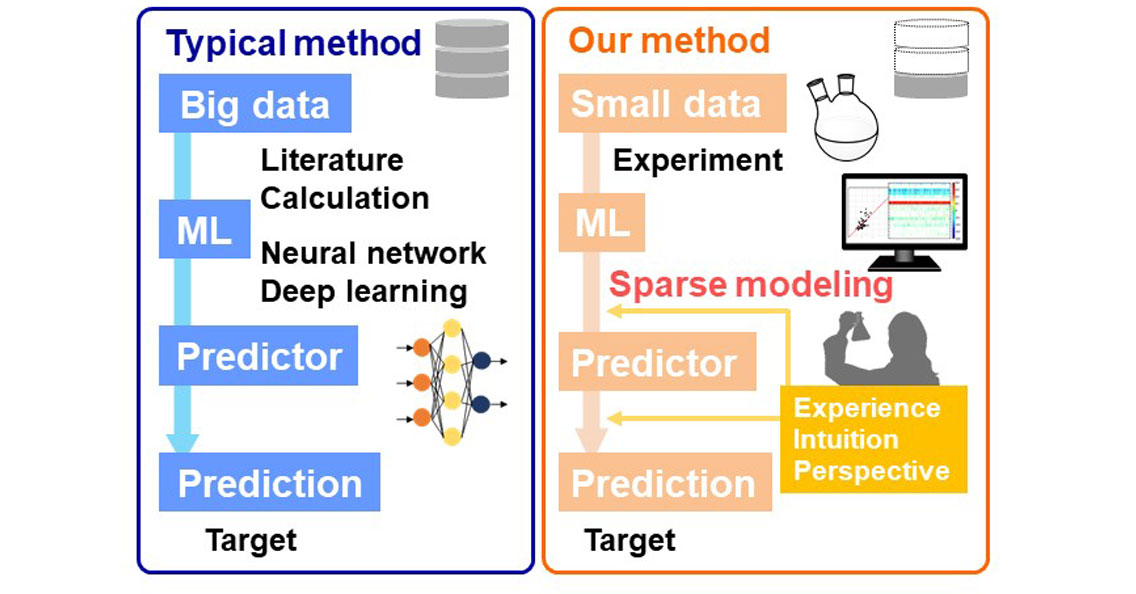
Related publications
- Adv. Theory Simul. 2019, 2, 1800180.
- Adv. Theory Simul. 2019, 2, 1900130.
- Adv. Theory Simul. 2020, 3, 2000084.
- Nanoscale 2021, 13, 3853.
- Chem. Commun. 2021, 57, 5921.
- Adv. Theory Simul. 2021, 4, 2100158.
- Digital Discovery 2022, 1, 26.
- ACS Appl. Energy Mater. 2022, 5, 2074.
- ACS Appl. Energy Mater. 2022, 5, 8990.
Accounts
- Bull. Chem. Soc. Jpn. 2021, in press.